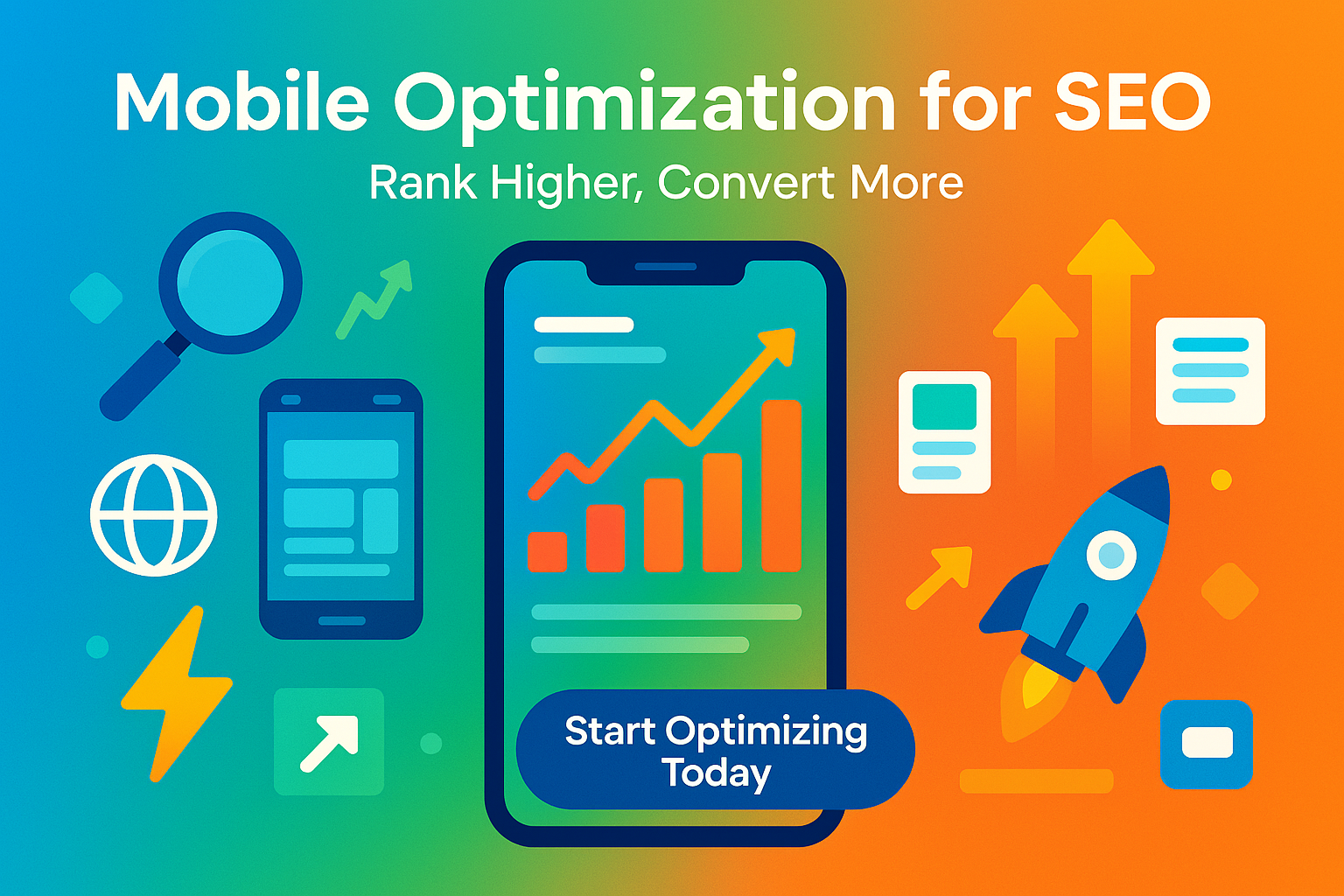Introduction: The Mobile-First Era 🚀
Here’s the harsh reality: if your website isn’t optimized for mobile in 2025, you are leaving massive money on the table. Plain and simple. Whether you’re running an e-commerce store, a blog, or a business website— Mobile Optimization for SEO isn’t just a buzzword, it’s a game-changer. Google has made it clear: if your site isn’t mobile-friendly, you WILL pay the price in lower search rankings.
The numbers are staggering. Did you know that over 60% of global web traffic comes from mobile devices? That means, if you aren’t catering to the millions of mobile users out there, you’re basically saying “I don’t want your business.” Google has even shifted to mobile-first indexing, meaning your mobile site version is what’s used to rank your site. No more ignoring it!
This guide is for anyone who is serious about driving more traffic, converting more visitors, and ultimately boosting their sales or influence online. Are you a business owner, digital marketer, or entrepreneur? If your goal is to take your digital presence to the next level, Mobile Optimization for SEO is the fuel your site needs to skyrocket.
But here’s the thing: optimizing your site for mobile isn’t just about having a responsive design. It’s about creating an experience that makes your users stick around—and convert. From ensuring lightning-fast loading times to making sure every image, button, and menu works seamlessly across all devices, every detail matters. Mobile Optimization for SEO doesn’t just improve your rankings—it improves your entire user experience. And guess what? A great user experience is key to winning customer trust and boosting your conversions.
In the sections ahead, you’ll discover actionable insights, proven strategies, and best practices for Mobile Optimization for SEO that will put you ahead of your competition. Whether you’re a small business trying to make it big, or an established player looking to improve, this post has something for everyone. 💥
We’ll also dive into tools that can help you test your website, monitor performance, and ensure you’re delivering the best possible experience for every user. You’ll learn what mistakes to avoid, and how to use insights from Google’s Mobile-Friendly Test to fine-tune your strategy.
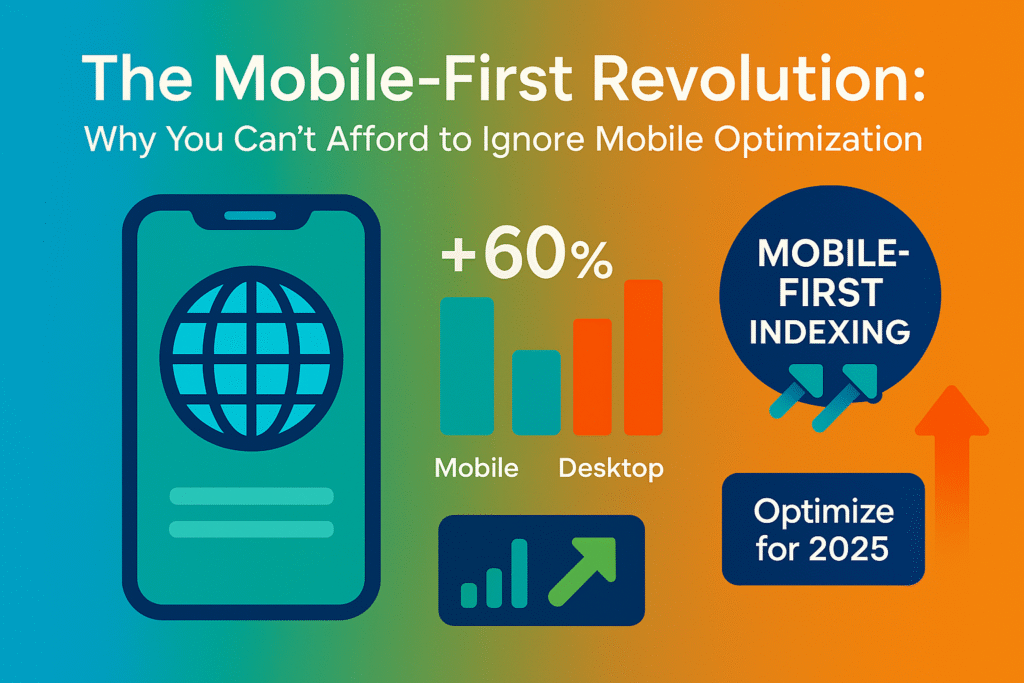
Are you ready to take charge of your mobile presence? Let’s dive deep and make sure your website isn’t just another brick in the wall of digital noise—it’s the one that stands out and makes waves. 🌊
Note: If you want more insights into the latest in digital marketing, you can also check out related blogs like Boost Your Local SEO for tips on local search optimization.
Section 1: Understanding Mobile Optimization 🚀
Before we dive into the nitty-gritty of tactics and tools, let’s get crystal clear on what Mobile Optimization for SEO really means.
You see, mobile optimization isn’t just about making sure your site looks decent on a smartphone. It’s about creating an experience that’s fast, easy to navigate, and ultimately leaves your visitors wanting more. You don’t want to be the website that’s slow, clunky, and frustrating to use. When people hit your site on their phones, they expect it to load quickly, be easy to read, and just work—period. If it doesn’t, they’re out, and they’re not coming back. The stats prove it: 53% of mobile users will leave a site if it takes more than 3 seconds to load. That’s a whole lot of lost opportunities if you’re not optimizing properly.
So what exactly is Mobile Optimization for SEO? It’s the process of ensuring your website is designed and built in such a way that it functions flawlessly on mobile devices. It involves responsive design, ensuring fast load times, making content easily accessible, and creating an overall mobile-friendly experience that works for all devices—smartphones, tablets, and everything in between. When done right, it results in better SEO rankings and, most importantly, a much better experience for your users.
But here’s the kicker: Mobile Optimization for SEO isn’t just a “nice to have.” It’s a necessity for anyone who wants to rank high on Google in today’s mobile-driven world. Google’s algorithms now prioritize mobile-first indexing, which means it looks at your mobile version of the website first and foremost when deciding how to rank your pages. So if you’ve got a great desktop site but a slow, broken mobile experience, guess what? Google is going to rank you lower. 🚨

Now, let’s break down the core elements that go into Mobile Optimization for SEO, because it’s not just about design—it’s about making sure your whole site works in harmony to please both Google and your users. From responsive web design to speed optimization and mobile-friendly content, every piece of the puzzle plays a vital role in ensuring your site doesn’t just survive the mobile-first world, but thrives in it.
Ready to get into the details? Good. Let’s go over the key elements of mobile optimization, so you can start seeing results almost immediately.
Section 2: Core Elements of Mobile Optimization ⚙️
When it comes to Mobile Optimization for SEO, there are key elements that you absolutely cannot ignore if you want to get ahead of the competition. If you’re serious about ranking higher on Google and giving your mobile visitors a top-notch experience, then you need to nail these core elements. Let’s break them down.
Responsive Web Design: The Foundation of Mobile Optimization
At the heart of mobile optimization lies responsive web design. In simple terms, this means your website is designed to adapt to any screen size, whether it’s a desktop, tablet, or smartphone. No more zooming in and out on your phone, no more squinting to read tiny text. A responsive design ensures that your site dynamically adjusts to give the best possible experience on any device.
Google loves responsive design for one simple reason: it makes life easier for both users and search engines. When you have a responsive website, Google can easily crawl your pages and index your content. Not only does this improve your SEO rankings, but it also prevents you from having to manage separate desktop and mobile sites, saving you time and money.
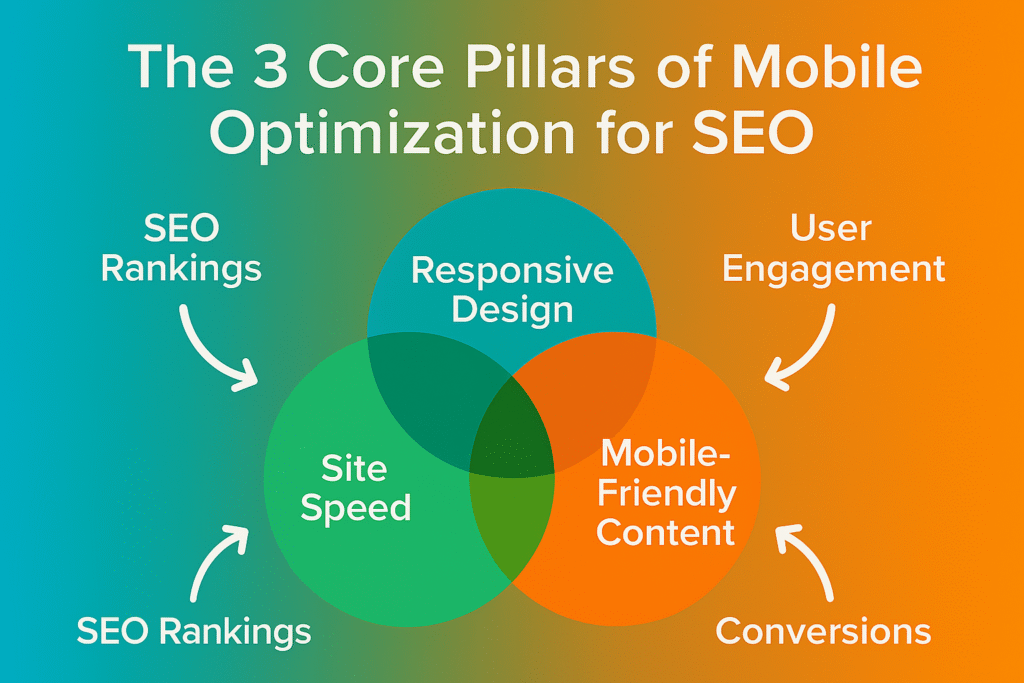
But here’s the deal: a site that’s “responsive” isn’t just about making things fit. It’s about delivering a seamless user experience across all devices. If your content is hard to read on a small screen, or if links are too small to click, you’ll lose visitors—and you’ll lose rankings. Mobile users expect simplicity, so make sure your design is sleek, easy to navigate, and fast-loading. Google’s algorithms reward this type of seamless experience. 💡
Site Speed and Performance: Speed Kills—In a Good Way!
You’ve heard it before, and you’ll hear it again: speed is EVERYTHING. And I’m not just talking about speed in terms of how quickly your site loads. I’m talking about mobile site performance. Google’s research has shown that 53% of mobile users will abandon a site if it takes more than 3 seconds to load. That’s a huge chunk of your potential traffic just slipping away!
Here’s the truth: Mobile Optimization for SEO and site speed go hand-in-hand. If your mobile website is slow, you can kiss your rankings goodbye. Google doesn’t just penalize slow sites; it actively rewards fast, mobile-friendly sites with better rankings. So, if you want to rank higher and deliver a better user experience, you need to focus on improving site speed.
What can you do? Start by optimizing your images. Compress them without losing quality. Use browser caching. Minimize JavaScript and CSS. And, most importantly, leverage Google’s PageSpeed Insights to see where you stand and what needs improvement. Don’t let a sluggish site hold you back!
Mobile-Friendly Content: Content That Pops on Any Device
So, your site looks great and loads fast—now it’s time to talk about content. It’s not enough for your content to be readable on desktop; it needs to be mobile-friendly, too. A good mobile-friendly website delivers content that is just as engaging, if not more so, on a small screen as it is on a large one.
What does this mean in practice? Start with font size. Make sure your text is large enough to read without zooming in, especially on mobile screens. Use short paragraphs and clear headings to make your content easy to scan. Mobile users typically browse in short bursts, so you need to get to the point quickly. Use clear calls-to-action (CTAs) and ensure they’re easy to tap on mobile devices. Don’t forget to format your content so it’s not overwhelming on smaller screens.
Also, make sure all images and videos are optimized for mobile viewing. Slow loading times, distorted images, or videos that don’t play well on mobile devices will drive users away—and Google will notice.
The goal is simple: provide a clean, user-friendly experience that encourages mobile users to stick around longer. The longer they stay, the better your chances of improving both your SEO rankings and conversions.
Next Steps: How to Ensure You’re Doing It Right
Now that you’ve got a good grasp of the core elements, the next step is to evaluate your current site and start implementing changes. This isn’t a one-size-fits-all approach. Every business, every website is different, and what works for one may not work for another. That’s why it’s so important to test and track everything. Use tools like Google Analytics and Google Search Console to monitor your mobile site’s performance and gather insights on where to make improvements.
But don’t worry—this guide will show you exactly what tools to use, how to test your mobile performance, and how to keep improving over time. Keep reading, and let’s dive deeper into how mobile-first indexing and SEO play a role in this whole equation.
Section 3: Mobile-First Indexing and SEO 📈
When Google talks, you listen. And right now, Google is talking loud and clear: Mobile-First Indexing is the new norm. If you’re not ready, your site is in serious trouble.
But what does mobile-first indexing mean, and why should you care about it in relation to Mobile Optimization for SEO? Let’s break it down.
What Is Mobile-First Indexing?
In simple terms, mobile-first indexing means Google now uses the mobile version of your website as the primary version for ranking in search results. Previously, Google used the desktop version of a website to determine its rankings. But as mobile traffic surged, Google realized that the mobile version of a site is often the most important for users. So, they switched things up.

In a mobile-first world, Google looks at how well your mobile site is structured, how fast it loads, and how optimized it is for mobile users before determining your rankings. So, if your mobile site is slow, difficult to navigate, or just plain unoptimized, it could drastically hurt your SEO performance.
You might be thinking, “I already have a mobile version of my site.” That’s great, but it’s not enough. Mobile Optimization for SEO has to be a priority if you want to stay competitive. You can no longer afford to simply create a mobile-friendly version of your website and call it a day. Your mobile site needs to be just as (if not more) optimized than your desktop site if you want to succeed.
Why Mobile-First Indexing Matters for SEO
Here’s the deal: Google is all about providing the best possible search experience for its users. If users are predominantly searching on mobile devices, Google wants to make sure the mobile site experience is flawless. And if your site isn’t mobile-friendly, you’ll get penalized.
But here’s the silver lining: when your site is optimized for mobile, Google rewards you. It’s not just about appearing on mobile search results—when you get Mobile Optimization for SEO right, you’ll climb up in the rankings, reach more people, and increase traffic and conversions. It’s a win-win!
If you’re serious about driving organic traffic, you’ll need to make sure your mobile site is designed with SEO in mind. Don’t just focus on the basics like font size or responsive images. Dive deeper into Mobile Optimization for SEO and make sure your entire mobile site is optimized, from metadata to internal links to structured data.
Aligning Content for Mobile-First Indexing
Now that we know mobile-first indexing is here to stay, the next step is aligning your content strategy for mobile-first indexing. This means ensuring that all your content—images, videos, copy, and even metadata—are optimized for mobile users.
Here’s what to focus on:
- Mobile-Friendly Content: Ensure your content is easily readable on mobile screens. Use short paragraphs, subheadings, and bullet points. Mobile users have limited screen real estate, so make it easy for them to digest your content quickly.
- Structured Data and Schema Markup: Make sure your content is rich with schema markup so search engines can easily understand and index it. Mobile Optimization for SEO and structured data go hand in hand—by giving Google clear signals about your content, you make it easier for the search engine to rank you higher.
- Internal Linking: On mobile devices, screen space is limited. Be strategic with your internal links. Ensure that your most important pages are easily accessible on mobile, without overwhelming users with too many options. Prioritize links that lead to pages with high-quality, relevant content.
- Meta Tags & Titles: While it might seem like a small detail, your meta tags and titles play a huge role in mobile SEO. Keep them concise and relevant for mobile users. Use keyword-rich, attention-grabbing titles and descriptions that make it easy for mobile users to quickly decide to click through.
If you nail mobile-first indexing, you’ll be ahead of your competition and set yourself up for better rankings. Google will reward your mobile-optimized site with higher visibility in search results—so don’t overlook these crucial steps!
Next Steps: Testing for Mobile Optimization
So now you understand mobile-first indexing and how critical it is for Mobile Optimization for SEO. But how do you know if your site is truly optimized for mobile? How do you make sure you’re ticking all the boxes Google cares about?
Stay tuned. In the next section, we’ll discuss the tools you need to test your mobile optimization, as well as how to monitor and improve your site’s performance. Plus, we’ll show you exactly how to avoid the most common pitfalls that hurt mobile SEO. Keep reading! 💡📱
Section 4: Enhancing User Experience on Mobile 📱
Alright, now that we’ve covered the technical side of Mobile Optimization for SEO, it’s time to dive into what really matters: User Experience (UX). This is where you separate yourself from the pack. Because let’s face it—if your website doesn’t provide an exceptional experience for your mobile visitors, you’re wasting your time.
User experience directly influences your SEO rankings, conversions, and, ultimately, your bottom line. Google loves rewarding sites that provide users with a great experience, and the mobile experience is no exception. So let’s break down exactly how you can make your mobile site as user-friendly as possible.

Intuitive Navigation: Make It Easy to Find What They Need
One of the biggest turn-offs for mobile users is poor navigation. You know what I’m talking about—menus that are hard to find, tiny buttons that are impossible to click, and endless scrolling. If users can’t quickly find what they’re looking for, they’ll bounce, and that’s bad news for both your SEO and your conversions.
A well-optimized mobile site should have a simple, intuitive navigation system that guides users to what they want in just a few taps. The key here is simplicity. Don’t overcomplicate things. Use sticky headers for easy access to the main menu, make sure your buttons are big enough to tap, and minimize the number of clicks needed to reach key pages.
You don’t want your mobile users hunting around for your contact page or your best-selling products. Make it easy for them to get there with clear, prominent calls to action (CTAs).
Touchscreen Optimization: Get Those Buttons Right!
Mobile devices are all about touch. So, if your buttons and links aren’t sized correctly for tapping, you’re basically forcing your users to play a frustrating game of “tap the tiny target.” Not only is this a terrible user experience, but it also impacts your mobile SEO because users are more likely to leave your site if they’re struggling to interact with it.
Here’s the simple fix: make your buttons big enough for easy tapping. Google recommends having at least 48px x 48px buttons, and you should space them out so that they don’t overlap or require precision. This makes it easy for users to click on what they want without frustration. Additionally, make sure that important links and CTAs are easily tappable.
When your mobile site is touch-optimized, users will stick around longer, and that’s a great signal to Google that your site provides value to visitors.
Accessibility Considerations: Making Your Site Inclusive
Accessibility is often overlooked in mobile optimization, but it’s absolutely crucial. In fact, Google prioritizes accessible websites, and if you’re not optimizing for accessibility, you could be losing valuable traffic. Accessibility doesn’t just mean making sure your site is usable for people with disabilities; it also ensures a better experience for all users.
A few quick tips to enhance accessibility on mobile:
- Text Contrast: Ensure that your text has high contrast against the background for easy readability.
- Alt Text for Images: Add descriptive alt text to your images so screen readers can describe them to users with visual impairments.
- Keyboard Navigation: Make sure your mobile site can be navigated by keyboard for users with motor impairments.
By making your mobile site accessible, you’re not only doing the right thing, but you’re also positioning yourself for better SEO and higher engagement rates.
Next Steps: Monitoring UX on Mobile
So, now that we’ve covered intuitive navigation, touchscreen optimization, and accessibility, the next thing you need to do is keep track of how users are actually interacting with your site. Tools like Google Analytics, Hotjar, and Crazy Egg can give you heatmaps, user session recordings, and detailed insights into how users behave on your mobile site.
You want to test different versions of your site to see what works best. A/B testing your CTAs, navigation, and button sizes can help you figure out what delivers the best user experience and keeps users engaged longer.
The better the user experience, the better your rankings and conversions will be. Trust me, when you focus on the mobile UX, everything else falls into place—better rankings, more traffic, and ultimately more sales.
Stay tuned, because in the next section, we’ll dive into Mobile SEO Best Practices, which will help you take everything you’ve learned and start optimizing your site for better mobile search rankings! 📊
Section 5: Mobile SEO Best Practices 📊
Now that your mobile site is optimized for a better user experience, it’s time to dive into the next phase: Mobile SEO Best Practices. This is where things get real—because even if your site is user-friendly, if it’s not properly optimized for mobile SEO, you’re still missing out on a massive opportunity to rank higher and attract more organic traffic.
Google’s mobile-first indexing is here to stay, and with it, mobile SEO has become the cornerstone of modern search engine optimization. This section will give you everything you need to make sure your mobile site is primed and ready for ranking in mobile search results. Let’s break down the mobile SEO tactics that you can implement right now.
Optimizing for Local Search: Dominate Local Rankings on Mobile
Did you know that mobile searches are 3x more likely to have local intent compared to desktop searches? Think about it—when people are on the go, they use their mobile phones to search for things like “near me,” “open now,” or “best [insert business type] nearby.”
This presents a huge opportunity for businesses, especially small and local ones, to stand out. If you’re not optimizing for local mobile search, you’re leaving money on the table. Here’s what you need to do:
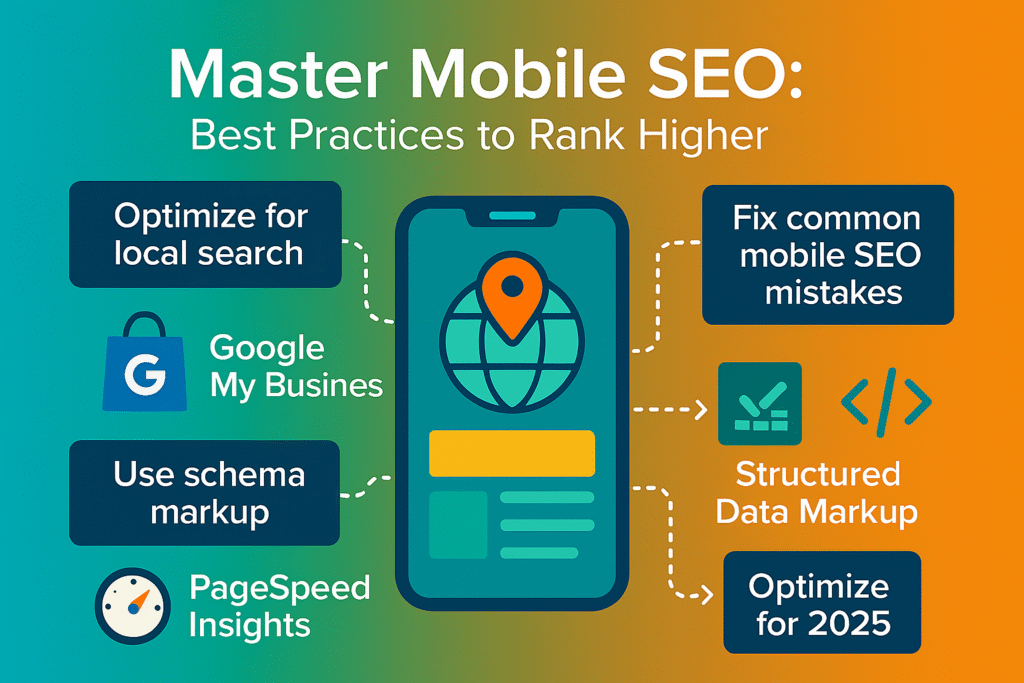
- Claim and Optimize Your Google My Business Listing: Make sure your business profile is up-to-date with accurate information like your address, hours of operation, and phone number.
- Leverage Local Keywords: Use local keywords in your mobile site’s content and meta tags. For example, if you run a restaurant in Chicago, include keywords like “best pizza in Chicago” throughout your content.
- Get Reviews: Positive reviews on mobile search results can boost your credibility and influence decisions. Encourage satisfied customers to leave glowing reviews on Google and other review platforms.
By optimizing for local search, you’ll dominate your geographic area and attract mobile users who are actively looking for your services.
Structured Data and Schema Markup: Make Your Content Search-Engine-Friendly
If you want to get noticed on mobile search results, you need to make sure your content is easy for search engines to understand. Enter structured data and schema markup.
Structured data uses a specific vocabulary of tags to help search engines understand your content more easily. It provides Google with additional context about your pages, which can help you show up in rich snippets (those awesome “answer boxes” at the top of search results).
For example, if you’re running an e-commerce site, implementing product schema can help you display star ratings, pricing, and availability directly in the search results. Similarly, if you have blog content, you can implement schema to help Google understand and rank your articles better.
The great thing about structured data is that it boosts your visibility, especially on mobile, where users often look for quick answers. The more you optimize your site with schema markup, the better chance you have of showing up in those valuable mobile-rich snippets.
Avoiding Common Mobile SEO Pitfalls
Even with the best of intentions, it’s easy to make mistakes when optimizing for mobile. But don’t worry, I’ve got your back. Here are the most common Mobile SEO Pitfalls to avoid:
- Mobile Site Redirects: Redirecting mobile users to a separate mobile site (e.g., m.yoursite.com) is outdated. Always use a responsive design that adjusts for all devices. Google doesn’t like redirects, and they can negatively impact your mobile SEO.
- Slow Mobile Page Load Times: As I mentioned earlier, mobile users are impatient. Slow load times can lead to high bounce rates and poor SEO. Test your page speed regularly and take steps to improve load times.
- Inconsistent Content Across Desktop and Mobile Versions: The last thing you want is to have different content on your desktop site and mobile site. Google doesn’t like this inconsistency. Ensure the same content is available on both versions.
- Ignoring Mobile User Intent: Mobile searchers often have different intent than desktop searchers. For example, they might be looking for something to buy immediately or seeking quick information. Make sure your mobile site caters to this by providing clear CTAs and easy navigation.
By avoiding these pitfalls, you’ll be in a much better position to maintain and improve your Mobile Optimization for SEO strategy.
Next Steps: Testing Mobile SEO Performance
Now that you’re equipped with the best mobile SEO practices, it’s time to test and track your site’s mobile performance. Tools like Google Search Console, Google Analytics, and Mobile-Friendly Test will help you identify areas of improvement.
Don’t just optimize and forget about it. Keep monitoring and tweaking your mobile SEO strategy for the best results.
Up next, we’ll dive into how to keep testing, monitoring, and improving your mobile site, plus the latest trends you need to be aware of to stay ahead in the game! Stay tuned. 📊
Resources to boost your Mobile Optimization for SEO:
Section 6: Testing and Monitoring Mobile Optimization 📉
Alright, you’ve implemented Mobile Optimization for SEO, and things are looking good—but how do you know it’s actually working? Without testing and monitoring, your efforts could be in vain. This is where data and continuous improvement come into play. It’s not a one-and-done deal. Mobile optimization is an ongoing process, and you need the right tools and strategies in place to make sure you’re always ahead of the game.
So, let’s talk about how to test, track, and monitor your mobile optimization efforts to ensure maximum impact.
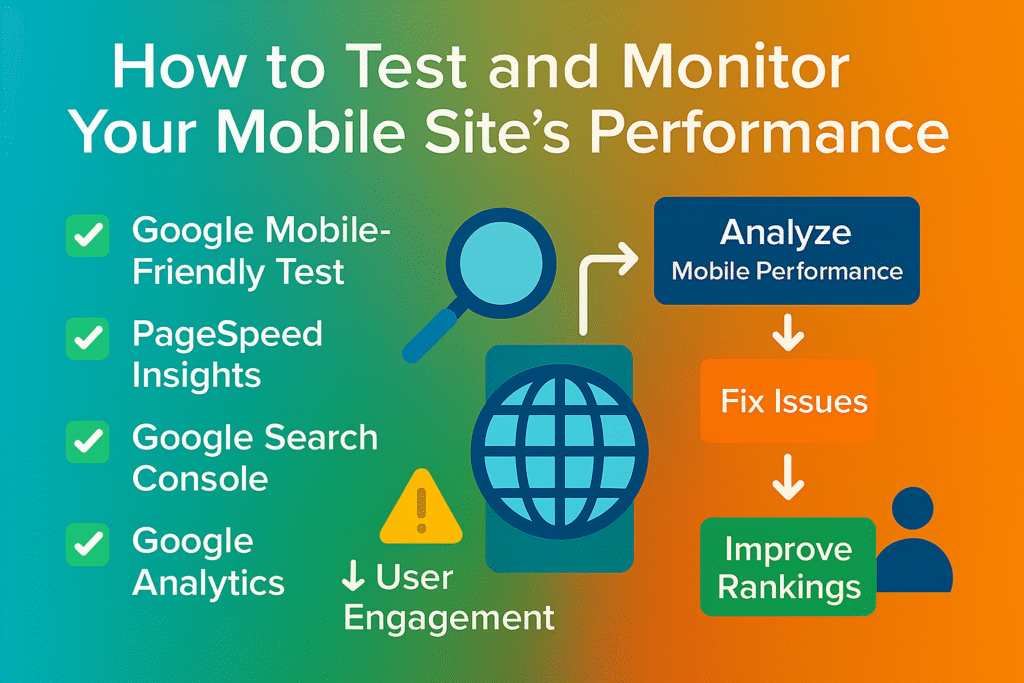
Using Google Tools to Measure Mobile Performance
Google provides a suite of tools that can help you test your website’s mobile performance and make sure it meets Google’s standards. Here’s how to leverage them:
- Google Mobile-Friendly Test: This tool is your first line of defense. It checks whether your website is optimized for mobile devices and gives you a mobile usability score. It’s simple to use—just enter your URL and hit “Test.” If your site isn’t mobile-friendly, Google will provide a list of issues that need to be fixed.
- PageSpeed Insights: Site speed is one of the most important factors in Mobile Optimization for SEO. Google’s PageSpeed Insights tool provides a detailed analysis of your page load times, both on mobile and desktop. It also suggests actionable improvements to make your pages load faster. Remember, Google rewards fast-loading sites, and users expect speed. Don’t let slow load times kill your SEO potential.
- Google Search Console: This is a powerful tool to help you monitor the health of your mobile SEO. Search Console gives you insights into how Google sees your website, including any mobile-specific issues. It tracks mobile usability, page indexing, and provides details about mobile traffic. If your pages are experiencing issues on mobile, Search Console will notify you.
- Google Analytics: While Google Analytics isn’t a dedicated mobile tool, it’s invaluable for monitoring mobile performance. Use it to track key metrics like bounce rates, session duration, and conversion rates from mobile traffic. If your mobile bounce rate is high, it’s a red flag that your site may not be optimized properly.
User Feedback and Analytics: A Goldmine of Insights
It’s easy to look at raw data and think everything is fine, but the real gold comes from user feedback. Tools like Hotjar and Crazy Egg offer heatmaps and session recordings that show how real users interact with your mobile site. With this data, you can see what’s working and where users are getting frustrated.
- Heatmaps: Visualize where users are tapping, scrolling, or ignoring on your mobile pages. This allows you to optimize the most important areas of your site.
- Session Recordings: Watch real user sessions to see exactly where they drop off, where they engage, and where they encounter issues.
User feedback helps you constantly refine your mobile optimization strategies. By paying attention to these insights, you can make data-driven decisions that significantly improve your mobile experience.
Continuous Improvement: Testing, Tweaking, and Updating
Once you’ve tested your site and analyzed the data, don’t stop there. Mobile optimization is an ongoing process. New mobile trends, user behaviors, and Google algorithm changes will continuously impact your rankings and performance. This means you need to constantly test, tweak, and update your site to stay ahead.
- A/B Testing: Test different versions of your site to see what works best. Whether it’s testing CTAs, page layouts, or button placements, A/B testing helps you optimize the user experience and maximize conversions.
- Monitor Mobile Traffic: Keep an eye on your mobile traffic trends. If traffic or engagement starts to decline, it’s time to reevaluate your optimization strategy. Similarly, if your mobile traffic is growing, it’s a good sign that your mobile SEO efforts are paying off.
- Stay Updated: SEO isn’t static. Mobile optimization, in particular, is always evolving. Keep up with the latest trends and changes in Google’s algorithms, user behavior, and mobile technology to ensure your site stays ahead of the curve.
Next Steps: Going Beyond Mobile Optimization
You’ve optimized for mobile, you’ve tested and tracked your site, and you’re continuously improving. But what comes next? In the final section, we’ll take a look at emerging trends in mobile optimization and how you can prepare your site for future shifts in the mobile and SEO landscape. From voice search to progressive web apps (PWAs), there are exciting developments you’ll need to keep an eye on to stay competitive.
Get ready, because the future of mobile optimization is only getting brighter! 🌟📱
Section 7: Future Trends in Mobile Optimization 🚀
The digital world is evolving at lightning speed, and if you think Mobile Optimization for SEO is just a one-time task, think again. The future of mobile optimization is already here, and staying ahead of the curve is critical if you want to maintain your competitive edge. As we move into 2025 and beyond, new technologies and shifts in user behavior will impact how mobile sites are optimized, and how they rank on search engines.
In this section, we’ll look at the top mobile optimization trends you need to pay attention to. It’s time to prepare for what’s next so you can stay ahead of the competition and continue driving traffic and conversions.
Voice Search Optimization: The New Frontier 🎤

If you haven’t been focusing on voice search, now’s the time to start. With the rise of smart speakers, virtual assistants like Siri, Google Assistant, and Alexa are becoming integral parts of users’ daily lives. In fact, 50% of all searches are expected to be voice searches by 2025. This means that if your mobile site isn’t optimized for voice search, you’re missing out on a huge traffic opportunity.
Voice search queries tend to be longer and more conversational compared to text-based searches. So, the key to optimizing for voice search is ensuring your content is structured to match these types of queries. Here’s how you can optimize for voice search:
- Use Natural, Conversational Language: Voice searches are often phrased in a question format. Use long-tail keywords and FAQs that answer common questions in your industry.
- Optimize for Local Search: Voice searchers are often looking for something nearby. Make sure your Google My Business profile is up to date, and include location-based keywords.
- Ensure Mobile-First Content: Voice searches are predominantly conducted on mobile devices, so ensuring your mobile optimization is top-notch will give you a significant advantage.
Optimizing for voice search isn’t just a trend—it’s becoming a must. If you want your site to show up in voice search results, start aligning your content with natural, conversational keywords and mobile-first practices.
Progressive Web Apps (PWAs): The Future of Mobile UX 🌐
Progressive Web Apps (PWAs) are changing the way we think about mobile websites. A PWA combines the best features of websites and mobile apps to deliver an incredible user experience. Think of it as a hybrid between a website and a mobile app—delivering fast, reliable, and app-like experiences directly from a browser.
Why should you care about PWAs? Here’s why:
- Lightning-Fast Speed: PWAs use service workers and caching techniques to ensure that your site loads almost instantly—even with slow connections.
- App-Like Experience: PWAs give users a native app-like experience without having to download anything. It’s a seamless experience with push notifications, offline capabilities, and smoother navigation.
- Better Engagement and Retention: With PWAs, users are more likely to return to your site. The offline capabilities and push notifications help keep users engaged and remind them of your site long after their first visit.
Google has already endorsed PWAs, and many major brands have seen massive improvements in performance and user engagement by implementing them. If you’re looking to push the boundaries of mobile optimization, a PWA could be your next move.
Artificial Intelligence and Personalization: The Power of Predictive UX 🤖
AI and machine learning are transforming every industry, and mobile optimization is no exception. With AI, you can deliver hyper-personalized experiences that are tailored to each individual user. This level of personalization will become increasingly important as users expect content that feels made just for them.
For example, AI can help deliver personalized product recommendations, dynamic content adjustments, and even predictive search suggestions. By understanding user behavior and preferences, AI can help you offer more relevant content to mobile users—keeping them engaged and more likely to convert.
Here’s how you can leverage AI and personalization for Mobile Optimization for SEO:
- Personalized Content: Use machine learning to analyze user behavior and provide personalized content recommendations based on their interests and past interactions.
- Predictive Search: Implement predictive search functionality that offers suggestions based on users’ search history, helping them find what they’re looking for faster.
- Dynamic UX: Customize the layout and design of your mobile site based on the user’s behavior. For example, frequent visitors might see a more streamlined interface, while first-time visitors see helpful introductory content.
AI and personalization are the future of mobile optimization. By integrating these technologies, you can stay ahead of your competition and deliver experiences that feel tailored specifically to your users.
Next Steps: Get Ahead of the Curve
Now that you’re armed with the knowledge of these emerging trends, it’s time to take action. Mobile optimization isn’t something you can do once and forget about. It’s a long-term strategy that requires constant innovation, testing, and adaptation.
- Start with Voice Search: Begin optimizing your content for voice search by focusing on conversational language and long-tail keywords.
- Explore PWAs: Consider implementing a PWA to give your users an ultra-fast, app-like experience that’s sure to boost engagement and conversions.
- Leverage AI: Start experimenting with AI-driven personalization tools to enhance user engagement and deliver better, more relevant experiences to your mobile visitors.
By staying ahead of these trends, you’ll not only improve your Mobile Optimization for SEO but also position yourself as a leader in the mobile-first era. The future of mobile optimization is bright, and now is the time to capitalize on it.
With these strategies in place, you’ll be ready to not just survive in the competitive digital landscape, but to thrive. Keep innovating, keep optimizing, and watch as your mobile rankings and conversions soar! 💥📈
FAQs (Frequently Asked Questions) ❓
At this point, you’re probably fired up and ready to put everything you’ve learned into action—but I’m sure you still have a few lingering questions. Don’t worry, I’ve got you covered. Here are some of the most common questions I hear about Mobile Optimization for SEO and their answers to help clear things up.
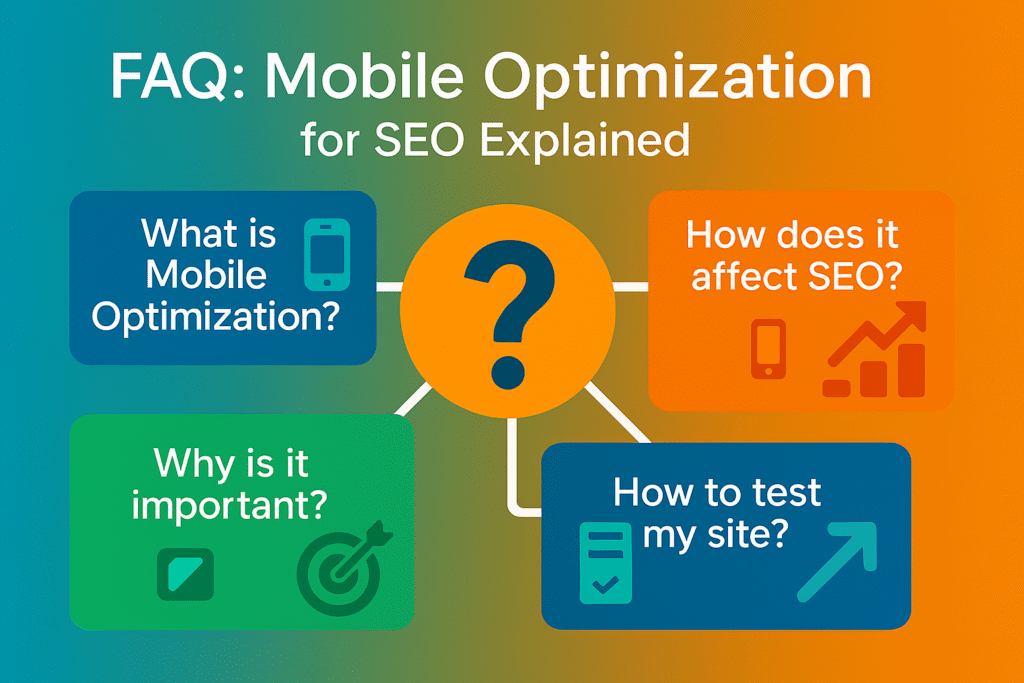
1. What is mobile optimization, and why is it important for SEO?
Mobile optimization is the process of making your website fully functional, user-friendly, and fast on mobile devices. This includes responsive design, fast page load times, and mobile-friendly content. It’s important for SEO because Google uses mobile-first indexing, meaning it ranks mobile-friendly websites higher. Poor mobile optimization can result in lower rankings, less traffic, and a higher bounce rate.
2. Does mobile optimization affect my Google rankings?
Absolutely. Since Google switched to mobile-first indexing, your mobile site’s performance is now the most important factor in your rankings. If your mobile site is slow, difficult to navigate, or unoptimized, it will negatively affect your SEO. Optimizing your mobile site not only helps improve your rankings, but it also boosts user experience, which is a key ranking factor.
3. What are the key factors to consider when optimizing for mobile?
Here are the key factors to focus on:
- Responsive Design: Ensure your site adjusts seamlessly across devices.
- Page Speed: Mobile users expect fast loading times—slow sites lose visitors.
- Mobile-Friendly Content: Make sure your text is legible, your images are properly sized, and CTAs are easy to tap.
- Navigation: Make it simple for users to find what they’re looking for without confusion.
4. How can I test if my website is optimized for mobile?
You can use several tools to test your website’s mobile optimization:
- Google Mobile-Friendly Test: Check if your site is mobile-optimized and get feedback on areas that need improvement.
- PageSpeed Insights: Analyze your mobile page load speed and receive recommendations for improvement.
- Google Search Console: Identify mobile usability issues directly from Google’s reporting tools.
5. What are the most common mistakes in mobile optimization?
Some of the most common mobile optimization mistakes include:
- Slow Load Times: A slow mobile site leads to higher bounce rates and lower rankings.
- Poor Navigation: Complex menus and tiny buttons lead to a frustrating experience.
- Not Using Responsive Design: Using separate mobile websites or fixed layouts can cause problems with Google’s mobile-first indexing.
- Ignoring Local Search Optimization: Not optimizing for local search means you’re missing out on mobile users searching for nearby businesses.
6. How does mobile optimization affect user experience?
A well-optimized mobile site enhances the user experience by ensuring that pages load quickly, content is easy to read, and navigation is seamless. A poor mobile experience, on the other hand, leads to frustrated visitors, high bounce rates, and lower conversions. Google also considers user experience as a ranking factor, so a smooth mobile experience not only helps keep visitors happy, but it boosts your SEO as well.
7. How often should I update my mobile optimization strategy?
Mobile optimization is an ongoing process. Regularly test your site’s performance, monitor analytics, and stay on top of emerging trends like voice search and progressive web apps (PWAs). Mobile technology and user expectations change frequently, so make it a habit to revisit your strategy and refine it every few months to keep up with the latest best practices.
8. How can I improve my mobile local SEO?
To improve your mobile local SEO:
- Claim and optimize your Google My Business listing with up-to-date contact info, hours, and location.
- Use local keywords in your content and meta tags (e.g., “best restaurant in [City]”).
- Get reviews from customers, as positive reviews can enhance your credibility and visibility in local mobile search results.
- Ensure NAP Consistency: Your Name, Address, and Phone Number (NAP) should be consistent across all platforms, including your website and local directories.
9. What are Progressive Web Apps (PWAs), and should I use them?
A Progressive Web App (PWA) is a hybrid between a website and a mobile app. PWAs load quickly, offer app-like experiences, and work offline. They can significantly improve user engagement and conversion rates by providing a seamless experience across devices. If you’re looking to push the boundaries of mobile optimization, PWAs are definitely worth considering.
10. How can I optimize for voice search?
To optimize for voice search:
- Use natural, conversational language in your content.
- Answer questions directly with short, concise answers in your content (think FAQ format).
- Optimize for local search since many voice searches are local in nature.
- Ensure your site is mobile-friendly, as most voice searches are done on mobile devices.
Final Thoughts: Let’s Dominate Mobile SEO! 🏆
By now, you’ve learned that Mobile Optimization for SEO is no longer optional. If you want to thrive in 2025 and beyond, mobile optimization must be at the core of your digital strategy. Whether it’s fast load times, intuitive design, or cutting-edge technologies like PWAs and voice search optimization, there’s a lot to consider.
But here’s the best part: by mastering these strategies, you’re not just optimizing for SEO—you’re enhancing user experience, increasing conversions, and staying ahead of your competitors.
Remember, the digital world is moving faster than ever, and mobile optimization isn’t a one-time fix. Keep testing, improving, and adapting your mobile strategy to stay at the top. 🚀
Ready to dominate mobile search? Start implementing what you’ve learned today, and watch your SEO rankings soar! 💥📱

